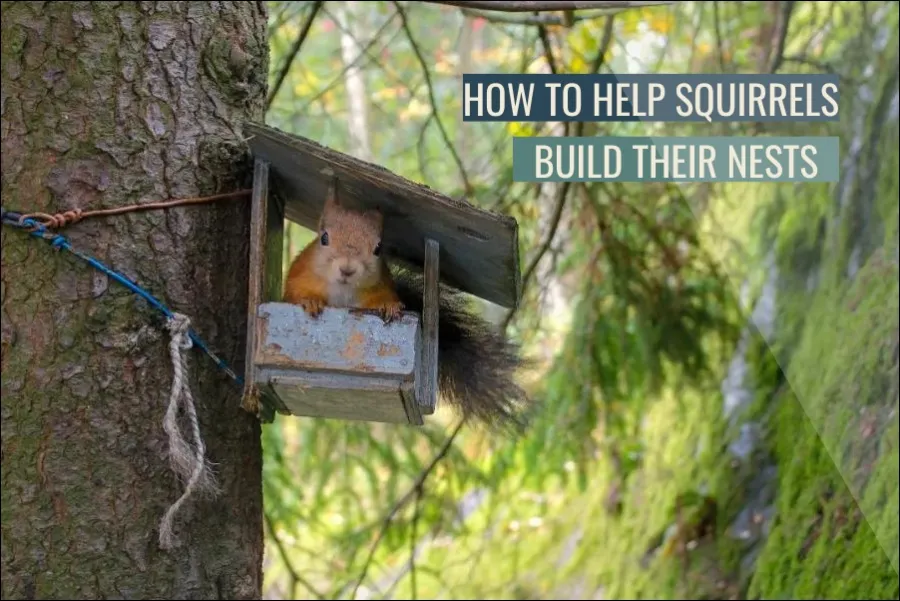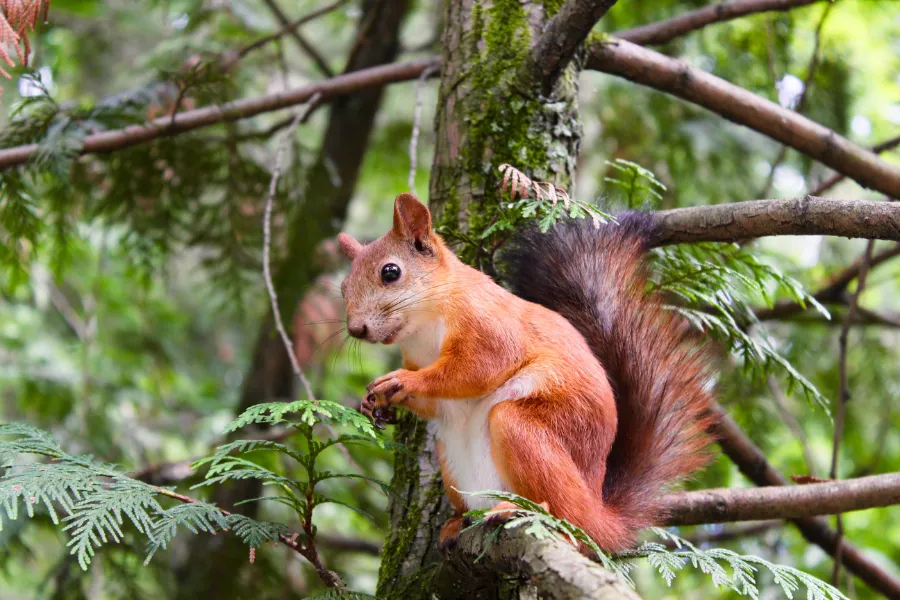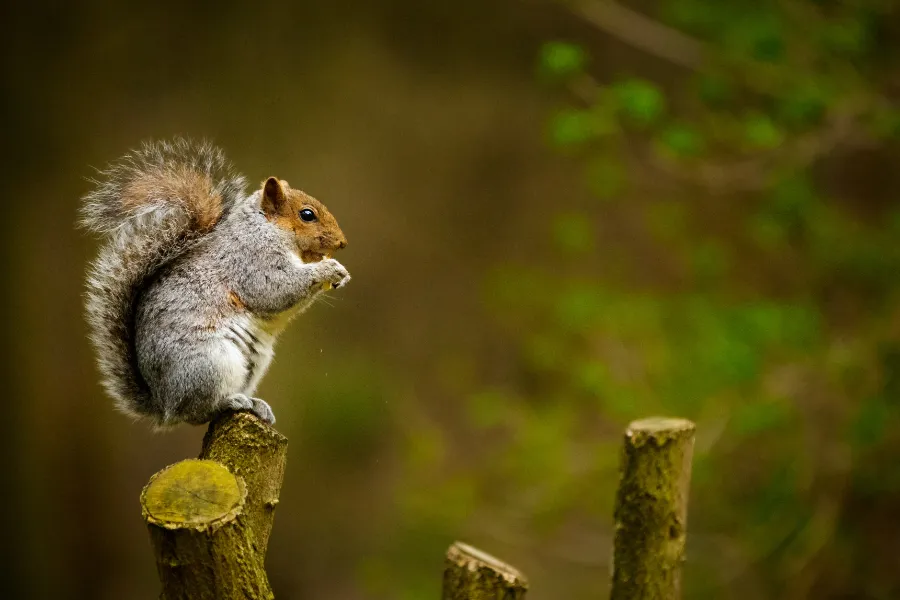
If you’ve ever watched a squirrel scurrying about, you’ve probably seen them collecting twigs, leaves, and other materials. These industrious creatures are building nests, or dreys, to keep themselves warm and protected from the elements.
But what can you do to help out your local squirrels and encourage them to build their dreys in your yard? Read on to learn more about how you can assist a squirrel in building their nest.
Understanding squirrel nesting behavior
Squirrels are noted for their hard work and ability to gather and store ingredients for their dreys, or nests. Squirrels are classified into three types: tree squirrels, ground squirrels, and flying squirrels, each with its own nesting patterns.
Tree squirrels, such as grey and red squirrels, are the most prevalent kind in cities and suburbs. They construct their dreys in trees, utilizing twigs, leaves, and grasses to create a robust and insulated construction. These nests are typically positioned at least 10-15 feet above ground and are reused or changed from year to year.
Ground squirrels, on the other hand, make their nests underground in burrows. These burrows may be rather large, with many chambers for sleeping, food storage, and rearing young. For comfort, ground squirrels may line their nests with soft materials.
Flying squirrels are the smallest squirrel species that have evolved to glide rather than climb. They build their nests in tree holes or nest boxes, utilizing moss, leaves, and feathers to make a snug and safe home.
Providing materials for nest-building
One technique to assist a squirrel in building a nest is to provide supplies for them to utilize. This is especially crucial in the fall, when squirrels are preparing for the winter. Squirrels may be drawn to the following materials:
- Twigs and branches: Squirrels prefer smaller twigs and branches that are easy to manipulate and carry. They will often break off larger branches into manageable pieces and carry them away to their nests.
- Leaves: Squirrels will often incorporate leaves into their nests to add insulation and comfort. They may gather fresh leaves in the fall or use dried leaves that have fallen to the ground.
- Grasses and plant fibers: Squirrels may use grasses and other plant fibers to line their nests and provide additional insulation. These materials can be found in gardens, meadows, and other areas with a variety of vegetation.
Creating a welcoming environment for squirrels
In addition to providing materials for nest-building, you can also create a welcoming environment for squirrels by providing food, water, and shelter.
- Food: Squirrels are omnivores and will eat a variety of foods, including nuts, seeds, fruits, and insects. You can attract squirrels to your yard by providing a feeder filled with their favorite treats, such as sunflower seeds, peanuts, or corn. Just be sure to avoid feeding squirrels foods that are unhealthy or unnatural for them, such as bread or processed snacks.
- Water: Squirrels need access to clean water, especially in the summer when temperatures are high. You can provide a water source by filling a shallow dish or birdbath with fresh water, or installing a squirrel-proof watering station.
- Shelter: Squirrels need a safe and secure place to rest and raise their young. You can provide shelter by planting native trees and shrubs that provide food and cover, or by building a nest box specifically for squirrels. Just be sure to locate the nest box in a safe and suitable location, such as a tree or pole, and to follow guidelines for proper construction and maintenance.

Building a nest box for squirrels
A squirrel nest box can provide a secure and comfortable environment for squirrels to rear their young. Nest boxes are especially beneficial for squirrels that cannot locate adequate nesting locations in natural holes or tree hollows.
To create a squirrel nest box, you must follow specific requirements to guarantee that it is safe, practical, and appealing to squirrels. Among the most important concerns are:
- Squirrel nest boxes should be large enough for the squirrels to roam around in, but not so huge that they are difficult to heat. A decent rule of thumb is to provide each squirrel at least six cubic feet of internal room.
- Materials: Squirrel nest boxes should be fashioned of weather-resistant materials such as cedar or redwood. It is also critical to utilize items that are safe for squirrels and will not hurt them if swallowed.
- Squirrels like to nest in places that are well-drained, wind-protected, and have good visibility. To defend against predators, place the nest box in an appropriate position, such as a tree or pole, and at a height of at least six feet.
- Proper ventilation is essential for preventing overheating and allowing air movement. Ventilation holes on the sides and rear of the nest box, as well as a screened aperture on the front, should be included to allow the squirrels to enter and escape.
- Cleaning: It is important to keep the nest box clean and well-maintained in order to prevent the accumulation of trash and parasites. After the squirrels have done rearing their young, you should clean out the nest box at least once a year.
Helping orphaned or injured squirrels
If you come across an orphaned or injured squirrel, it’s important to take care not to interfere with their natural behavior. However, there are steps you can take to help provide care and support.
- Orphaned squirrels: If you come across a squirrel that looks to be orphaned, you should first assess whether the animal is actually in need of help. Young squirrels are frequently left alone for brief periods of time while their moms seek for food. If the squirrel looks to be in good condition and is not in imminent danger, it is better to leave it alone and observe from a safe distance. If the squirrel seems damaged or agitated, or if you cannot find the mother, you may need to contact a wildlife rehabilitation clinic.
- Injured squirrels: If you come across a squirrel that looks to be injured, proceed with caution and avoid handling the animal unless absolutely necessary. If the squirrel is in immediate danger, carefully relocate it to a more secure area, such as a nest box or cardboard box. However, keep in mind that squirrels are unpredictable and may bite or scratch if they feel threatened. If the squirrel’s injuries are serious or you are unable to offer adequate treatment, it is recommended to seek help from a wildlife rehabilitation clinic.
Tips for coexisting with squirrels
- If squirrels are raiding your bird feeders or devouring your plants, try giving an alternate food source, such as a squirrel feeder or a specific place for growing seeds or nuts. This might assist to shift their focus and lessen competition.
- Protect your plants: If squirrels are digging up your plants or devouring your fruit, you can use fence, netting, or repellents to keep them out. You might also try growing squirrel-resistant plants or establishing a distinct foraging area for squirrels.
- Safe your trash cans and compost bins: Squirrels are drawn to trash cans and compost bins, so keep these sites secure to prevent them from getting into your junk. To keep squirrels out, use lids or other barriers, and consider using a garbage can with a locking mechanism or a compost bin with a tight-fitting cover.
- Squirrels can be deterred from entering your home or causing damage to your property by sealing any openings or gaps, cutting tree branches that give access, and applying repellents or other deterrents. You can also seek the advice and aid of a pest control specialist.
The importance of respecting wild animals
It’s critical to remember that squirrels are wild creatures, and we must respect their natural behavior and environment. Here are some guidelines for treating squirrels and other wild creatures with respect:
- Observe from a safe distance: While it’s fun to go near to squirrels and other animals, keep in mind that they’re not tamed pets and may be scared or upset by human presence. Wildlife should be observed from a safe distance, preferably with binoculars or a telescopic lens.
- Feeding wild animals is not permitted: While it may be tempting to feed squirrels or other wildlife, keep in mind that they have evolved to obtain their own food and that human handouts might be harmful or unnatural for them. Planting native plants and utilizing species-appropriate feeders can help supply food for wildlife.
- Respect nesting grounds: If you come across a squirrel nest or other wildlife habitat, leave it alone and avoid interfering with the animals’ normal activity. You can see and photograph the creatures from a safe distance, but you should not touch or handle them or their nests.
- Obey all local rules and regulations: Each place has its own animal rules and restrictions, so it’s critical to be aware of and respect them. Obtaining licenses or adhering to certain criteria for feeding, nesting, or caring for wild animals may be part of this.

Frequently asked questions about squirrel nest-building
Here are some frequently asked questions and answers concerning squirrel nest-building:
How do squirrels construct their nests?
Squirrels construct their nests from of a range of materials, including twigs, leaves, grasses, and plant fibers. They will collect these resources from their surroundings and utilize them to build a strong and well-insulated building.
Where do squirrels construct their nests?
Nests are built in a number of sites by squirrels, depending on the species and its surroundings. Tree squirrels make their nests in trees, whilst ground squirrels build their nests underground in tunnels. Nests of flying squirrels can be found in tree cavities or nest boxes.
Can I make a squirrel nest box?
Yes, you may construct a nest box for squirrels to provide them with a secure and pleasant environment in which to raise their young. It is critical to follow design and placement rules, as well as to respect the squirrels’ natural behavior and environment.
Can I relocate a squirrel’s nest?
Moving a squirrel nest is typically not suggested since it might be disturbing to the animals and cause stress or injury. If you have a squirrel nest that is causing a problem or is in a dangerous area, it is recommended to get advice from a wildlife rehabilitation facility or another specialist on how to proceed.
Can I get my hands on a squirrel nest?
Touching a squirrel nest is typically not suggested since it might be disturbing to the animals and cause stress or injury. If you stumble across a squirrel nest, it’s preferable to view from a safe distance and snap photographs instead of touching the nest or the animals. If you have worries about a squirrel nest, you should seek advice from a wildlife rehabilitation organization or another specialist.
Additional resources for helping squirrels
If you are interested in learning more about squirrels and how you can help them, there are many resources available online and in your community. Some options to consider include:
- Wildlife rehabilitation centers: Wildlife rehabilitation clinics are specialist institutions that care for and rehabilitate wounded, orphaned, or sick wild creatures such as squirrels. They may be able to provide aid in certain circumstances and provide information and suggestions on how to help squirrels in need.
- Local nature centers or wildlife organizations: Many nature centers and wildlife groups in the area provide educational programs, activities, and materials about squirrels and other animals. They could know how to make a nest box, provide food and shelter, or live peacefully with squirrels.
- Online resources: There are several online resources available on squirrels and how to aid them. Consider websites, blogs, forums, and social media groups devoted to squirrels and animal conservation. For information and assistance, you can also turn to recognized sources such as government agencies, scientific organizations, and conservation groups.
Conclusion: Making a difference for our furry neighbors
Squirrels are a vital and intriguing part of the natural world, and we can help these charming critters thrive in our communities by learning about their nesting habits and offering aid. You may help squirrels and other animals by following the recommendations and advice in this article, and you can enjoy the numerous benefits of coexisting peacefully with these lovely critters.
In conclusion, this article has discussed how to assist a squirrel in building a nest, including understanding their nesting habit, giving supplies, establishing a welcome atmosphere, constructing a nest box, and respecting wild animals. You can help squirrels construct their dreys and make a difference in your neighborhood by following these instructions and searching out further information.
